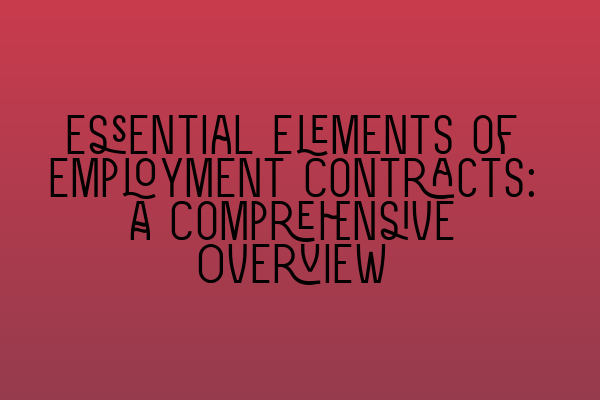Essential Elements of Employment Contracts: A Comprehensive Overview
When it comes to employment contracts, it’s crucial to understand the essential elements that should be included to protect both employers and employees. These elements provide the framework for the employment relationship and ensure that both parties are aware of their rights and obligations. In this article, we will provide a comprehensive overview of the essential elements of employment contracts.
1. Job Title and Description
Every employment contract should clearly specify the job title and description of the employee. This provides clarity on the role they will be performing within the organization and helps avoid misunderstandings regarding responsibilities.
For example, if an employee is hired as a Marketing Manager, their contract should clearly state that their primary role is to develop and execute marketing strategies, manage the marketing team, and achieve marketing objectives.
2. Compensation and Benefits
The employment contract should outline the agreed-upon compensation and benefits package for the employee. This includes their salary or hourly rate, payment frequency, and any additional benefits such as health insurance, retirement plans, or vacation/sick leave entitlements.
It’s essential to clearly define how the employee’s compensation will be calculated, whether it’s based on an hourly rate, an annual salary, or other factors. This prevents disputes or misunderstandings related to payment.
Furthermore, the contract should specify any performance-based incentives or bonuses, including the criteria that need to be met for the employee to be eligible for these additional rewards.
3. Employment Type and Duration
The contract should clearly state the type of employment, whether it’s a full-time, part-time, fixed-term, or temporary position. This helps establish the expectations in terms of working hours and duration of employment.
If the position is fixed-term or temporary, the contract should include a specific end date or condition for termination. This provides clarity on the expected duration of employment and any potential renewal or extension options.
4. Probationary Period
Many employment contracts include a probationary period during which the employer can assess the employee’s suitability for the role. This period is typically shorter than the regular employment term and allows for termination without lengthy notice periods or severance pay if the employee’s performance is unsatisfactory.
The contract should clearly outline the duration of the probationary period and any specific terms or conditions that apply during this time.
5. Hours of Work and Overtime
The contract should specify the expected working hours for the employee, including any provisions for overtime. This ensures that both parties have a clear understanding of the expected time commitment and any additional compensation for working beyond regular hours.
Additionally, the contract should outline any rest periods or breaks that the employee is entitled to during the working day, in accordance with employment laws and regulations.
6. Confidentiality and Non-Disclosure
Many employment contracts include provisions regarding confidentiality and non-disclosure to protect the employer’s sensitive information, trade secrets, and intellectual property. These clauses prohibit the employee from sharing or misusing confidential information both during and after their employment.
It’s essential to clearly define what constitutes confidential information and the consequences of breaching these provisions, such as legal action or termination.
For a deeper understanding of legal challenges and pitfalls in the employment field, check out our article on Legal Challenges and Pitfalls: Navigating the Complexities of the Legal System.
7. Termination and Severance
The employment contract should outline the terms and conditions for termination, including notice periods, grounds for termination, and any severance packages or payments upon the termination of employment.
By clearly defining these terms, both parties can understand their rights and obligations in the event that the employment relationship needs to be terminated.
8. Dispute Resolution
It’s advisable to include a clause in the employment contract that outlines the preferred method of dispute resolution, such as mediation or arbitration, should any conflicts arise between the employer and employee.
This can help streamline the resolution process and reduce the need for lengthy and costly legal proceedings. For more information on alternative dispute resolution, read our article on Exploring Alternative Dispute Resolution: An Effective Approach to Legal Conflicts.
Conclusion
Employment contracts are crucial documents that establish the rights and responsibilities of both employers and employees. By including the essential elements discussed in this article, employers can ensure that their contracts are comprehensive and legally sound.
If you’re an aspiring solicitor looking for guidance on your legal journey, consider exploring our article on Mentorship for Aspiring Solicitors: Nurturing Talent in the Legal Field.
For more information on the Solicitors Qualifying Examination (SQE) and what you need to know about it, check out our article on Demystifying the Solicitors Qualifying Examination (SQE): What You Need to Know.
